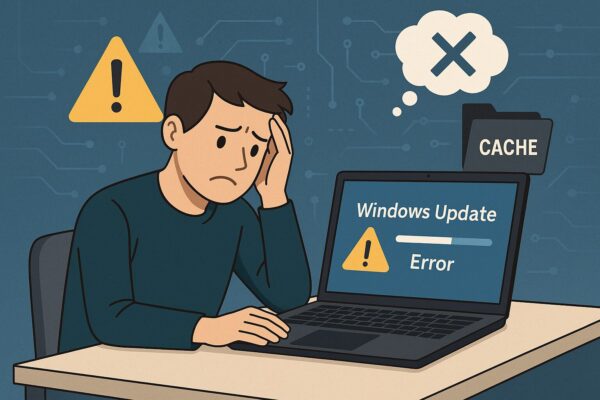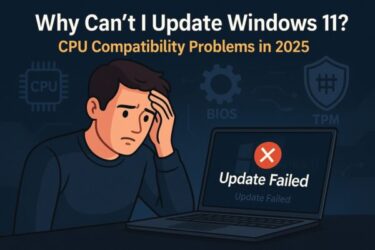
- 1 Feeling Stuck with Windows Updates? Clearing the Cache Might Help
- 2 Step-by-Step: How to Clear the Windows Update Cache
- 3 What These Folders Contain — and Why It’s Safe to Clear Them
- 4 ⚠️Never Delete These Folders
- 5 Still Not Working? Try These Advanced Commands
- 6 June 2025 Update Notes
- 7 Frequently Asked Questions
- 8 Final Thoughts
Feeling Stuck with Windows Updates? Clearing the Cache Might Help
Have you ever tried to quickly get your work done, only to find Windows Update acting up—stuck, throwing errors, or slowing down your system?
One of the lesser-known but surprisingly common causes of update failures is the Windows Update cache. Over time, this cache can become cluttered with old or corrupted files, preventing new updates from being applied properly.
In this guide, we’ll walk you through how to safely clear the Windows Update cache, explain which folders can be deleted, which ones you should never touch, and offer additional troubleshooting tips if clearing the cache isn’t enough.
Step-by-Step: How to Clear the Windows Update Cache
- Stop the Windows Update service
– PressWindows + R, typeservices.msc, and press Enter.
– Find “Windows Update” in the list, right-click it, and choose Stop. - Delete files inside the cache folders
– Navigate to:C:\Windows\SoftwareDistribution
– Open both the Download and DataStore folders.
– Delete all files and folders inside them.
⚠️ Do not delete theSoftwareDistributionfolder itself. - Restart the Windows Update service
– Go back toservices.msc, right-click “Windows Update”, and click Start. - Restart your PC
– A reboot ensures that the changes take full effect.
What These Folders Contain — and Why It’s Safe to Clear Them
1. Download Folder
This contains temporary files downloaded for Windows updates. Once the updates are installed (or fail to install), these files are often no longer needed. It’s safe to delete them — Windows will redownload anything it needs later.
Note: Only delete the contents, not the folder itself.
2. DataStore Folder
This folder holds logs and metadata related to your update history. Deleting its contents will reset your update history view in Settings, but it won’t remove any installed updates. It’s safe to clear if you’re troubleshooting.
⚠️Never Delete These Folders
- The SoftwareDistribution folder itself
- EventCache folder (if present)
- Any other subfolders you don’t recognize — unless you know exactly what they are for
These folders are critical to the functioning of Windows Update. Deleting them entirely may cause severe issues that require system repair.
Still Not Working? Try These Advanced Commands
If clearing the cache didn’t fix the problem, these system-level repair tools often help:
- SFC (System File Checker)
– Open Command Prompt as Administrator
– Run:sfc /scannow
This scans and repairs system file corruption. - DISM (Deployment Image Servicing and Management)
– Run these commands in order:DISM /Online /Cleanup-Image /CheckHealthDISM /Online /Cleanup-Image /ScanHealthDISM /Online /Cleanup-Image /RestoreHealth
These commands check and repair the system image that Windows uses for updates.
June 2025 Update Notes
- Some users have experienced failures with KB5060842 and KB5063060. Manually clearing the cache may help in those cases.
- Windows 11 24H2 has introduced new update bugs, including frozen update progress and post-update freezes.
- When using Storage Sense (Settings > System > Storage), make sure it doesn’t automatically delete important temp files related to ongoing updates.
Pro Tip: Use Standalone Installers
If all else fails, you can manually download the update from the Microsoft Update Catalog and run the .msu file. This bypasses the built-in update process and often succeeds where automatic updates fail.
Frequently Asked Questions
- Q: Is it okay to delete the SoftwareDistribution folder?
A: No. Only delete the contents ofDownloadandDataStorefolders inside it. - Q: Will clearing the cache remove installed updates?
A: No. Installed updates remain; only history and temporary files are affected. - Q: Can I do this regularly?
A: It’s not necessary unless you’re actively troubleshooting update errors.
Final Thoughts
Knowing how to clear the Windows Update cache can save you a lot of time and frustration. It’s a simple but powerful step when your PC refuses to update properly.
That said, always proceed carefully when modifying system files or folders — and if you’re unsure, consult a trusted technician or IT support service.
Stay updated, stay safe — and don’t forget to back up your data regularly!
✔️You might also find these helpful:
▶︎How to Fix Windows C Drive Permission Errors (Full Recovery Guide)
▶︎10 Essential Things to Do First When You Get a New Windows PC (Beginner-Friendly Guide)
▶︎Windows Troubleshooter Failed or Not Working — Complete Fix Guide (With Extra Tips)


![[June 2025 Update] Can Your PC Upgrade to Windows 11? How to Check Compatibility – Including New Free ESU Program for Windows 10 Users](https://kimiyoya.com/wp-content/uploads/2025/06/855CF664-BC55-4181-A797-71CE61F5C973-375x250.jpg)